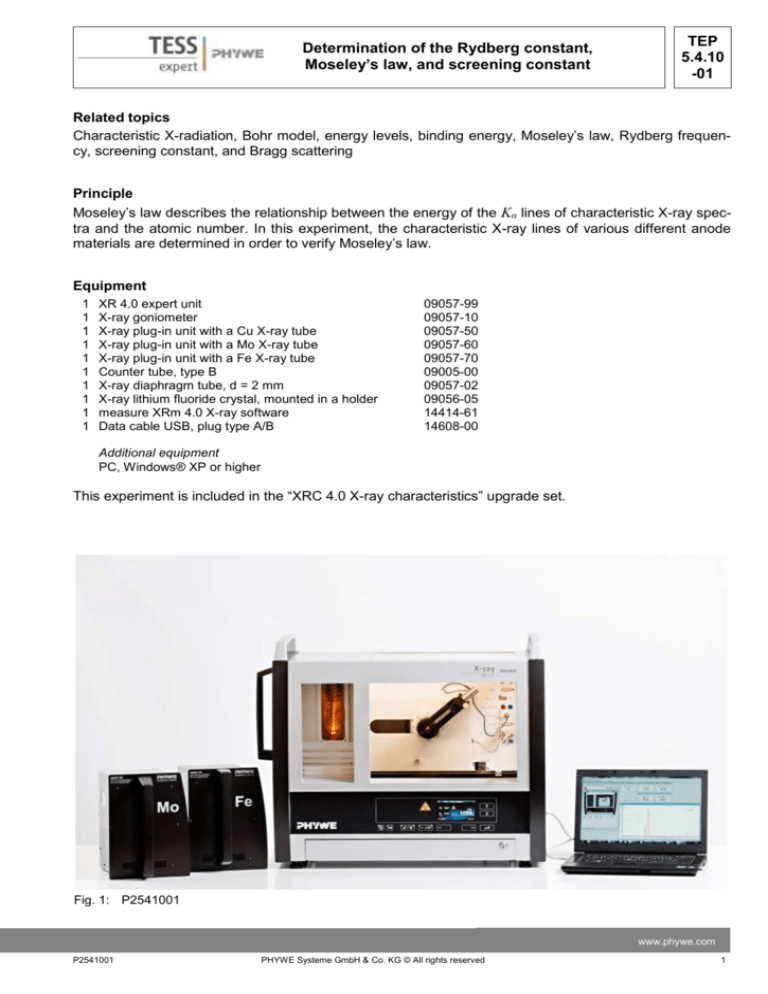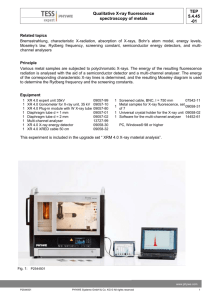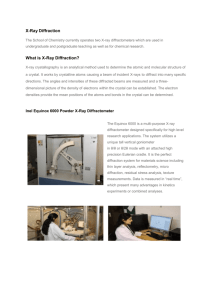
Determination of the Rydberg constant,
Moseley’s law, and screening constant
TEP
5.4.10
-01
Related topics
Characteristic X-radiation, Bohr model, energy levels, binding energy, Moseley’s law, Rydberg frequency, screening constant, and Bragg scattering
Principle
Moseley’s law describes the relationship between the energy of the Kα lines of characteristic X-ray spectra and the atomic number. In this experiment, the characteristic X-ray lines of various different anode
materials are determined in order to verify Moseley’s law.
Equipment
1
1
1
1
1
1
1
1
1
1
XR 4.0 expert unit
X-ray goniometer
X-ray plug-in unit with a Cu X-ray tube
X-ray plug-in unit with a Mo X-ray tube
X-ray plug-in unit with a Fe X-ray tube
Counter tube, type B
X-ray diaphragm tube, d = 2 mm
X-ray lithium fluoride crystal, mounted in a holder
measure XRm 4.0 X-ray software
Data cable USB, plug type A/B
09057-99
09057-10
09057-50
09057-60
09057-70
09005-00
09057-02
09056-05
14414-61
14608-00
Additional equipment
PC, Windows® XP or higher
This experiment is included in the “XRC 4.0 X-ray characteristics” upgrade set.
Fig. 1: P2541001
www.phywe.com
P2541001
PHYWE Systeme GmbH & Co. KG © All rights reserved
1
TEP
5.4.10
-01
Determination of the Rydberg constant,
Moseley’s law, and screening constant
Tasks
1. Record the X-ray spectra of the three X-ray tubes.
2. Determine the wavelengths and frequencies of the characteristic X-ray lines based on the Bragg angles of the lines.
3. Create the Moseley lines and determine the Rydberg constant and screening constant.
Set-up
Connect the goniometer and the Geiger-Müller counter tube to
their respective sockets in the experiment chamber (see the red
markings in Fig. 2). The goniometer block with the analyser
crystal should be located at the end position on the right-hand
side. Fasten the Geiger-Müller counter tube with its holder to the
back stop of the guide rails. Do not forget to install the diaphragm in front of the counter tube (see Fig. 3).
Insert a diaphragm tube with a diameter of 2 mm into the beam
outlet of the tube plug-in unit for the collimation of the X-ray
beam.
For calibration: Make sure, that the correct crystal is entered in
the goniometer parameters. Then, select “Menu”, “Goniometer”,
“Autocalibration”. The device now determines the optimal positions of the crystal and the goniometer to each other and then Fig. 2: Connectors in the experiment
chamber
the positions of the peaks.
GM-counter
tube
Goniometer at
the end position
Diaphragm tube
Counter tube
diaphragm
Mounted
crystal
Fig. 3: Set-up of the goniometer
2
PHYWE Systeme GmbH & Co. KG © All rights reserved
P2541001
TEP
5.4.10
-01
Determination of the Rydberg constant,
Moseley’s law, and screening constant
Note
Details concerning the operation of the X-ray unit
and goniometer as well as information on how to
handle the monocrystals can be found in the respective operating instructions.
Procedure
- Connect the X-ray unit via USB cable to the
USB port of your computer (the correct port of
Fig. 4: Connection of the computer
the X-ray unit is marked in Fig. 4).
- Start the “measure” program. A virtual X-ray unit
will be displayed on the screen.
- You can control the X-ray unit by clicking the
various features on and under the virtual X-ray
unit. Alternatively, you can also change the parameters at the real X-ray unit. The program will
automatically adopt the settings.
- Click the experiment chamber (see the red
marking in Figure 5) to change the parameters
for the experiment. Start angle: 3°-4°. Record
the spectra at least up to the second-order
characteristic lines.
For setting the
For setting the
- If you click the X-ray tube (see the red marking
X-ray tube
goniometer
in Figure 5), you can change the voltage and
current of the X-ray tube. Select the settings as
shown in Figure 7.
- Start the measurement by clicking the red circle
Fig. 5: Part of the user interface of the software
-
-
-
After the measurement, the following window
appears:
Select the first item and confirm by clicking
OK. The measured values will now be transferred directly to the “measure” software.
At the end of this manual a short introduction
to the evaluation of the resulting spectra is
given.
Overview of the settings of the goniometer
and X-ray unit:
- 2:1 coupling mode
- Gate time 2 s; angle step width 0.1°
- Start angle: 3°-4°. Record the spectra at
least up the second-order characteristic
lines.
- Anode voltage UA = 35 kV; anode current
IA = 1 mA
Note
Never expose the Geiger-Müller counter tube to the primary X-radiation for an extended period of time.
www.phywe.com
P2541001
PHYWE Systeme GmbH & Co. KG © All rights reserved
3
TEP
5.4.10
-01
Determination of the Rydberg constant,
Moseley’s law, and screening constant
Fig 7: Voltage and current settings
Theory
H. G. J. Moseley discovered the relationship between the energy of the Kα lines of characteristic X-ray
spectra and the atomic number. If the root of the frequency of the Kβ line is plotted as a function of the
atomic number Z of the anode material, a straight line results.
Based on this straight line, the order of the elements in the periodic table of elements was specified in a
definite manner for the very first time. The element hafnium (Hf) (Z = 72) that had been unknown hitherto, was represented as a gap on Moseley’s straight line. Following the discovery of hafnium and the recording of the X-ray spectrum, the element fitted right into this gap, which substantiated Moseley’s findings.
The following is valid for the binding energy En of an electron on a shell with the principal quantum number n:
En
me e 4
Z 2 12 where (n=1, 2, 3, …)
2 2
8 0 h
n
Electron mass
Elementary charge
Planck's constant
Dielectric constant
Atomic number
Screening constant
me
e
h
ε0
Z
σ
(1)
= 9.1091∙10-31 kg
= 1.6021∙10-19 As
= 6.6256∙10-34 Js
= 8.8544∙10-12 N-1m-2C2
During the transition of an electron from L shell to a free space on the K shell of an atom, the energy that
is released can be converted into X-radiation. The frequency f of this quantum can be determined with
the aid of equation (1):
f
E me e 4
1
2 1
2 3 Z 2 2 Moseley's law
h
8 0 h
n1 n2
(2)
1
2 1
f R Z 2 2
n1 n2
4
PHYWE Systeme GmbH & Co. KG © All rights reserved
P2541001
TEP
5.4.10
-01
Determination of the Rydberg constant,
Moseley’s law, and screening constant
( fR
me e 4
3.2899 1015 s 1 = Rydberg frequency)
8 02 h 3
With n1= 1 and n2= 2, it follows from (2) that:
f
1
3 f R Z
2
(3)
If the interplanar spacing d of the analyser crystal is known, the glancing angles ϑ of the characteristic
Kα and Kβ lines can be used to determine the wavelengths λ of the lines based on Bragg’s law.
2d sin n (n=1, 2, 3,…)
(4)
(LiF(200) interplanar spacing d = 201.4 pm)
The associated frequencies f of the characteristic lines result from:
c f (velocity of light c = 2.9979∙108 m/s).
Evaluation
Task 1: Record the X-ray spectra of the three Xray tubes.
The X-ray spectra of iron, copper, and molybdenum with the LiF crystal as the analyser are
shown in Figure 8a-8c.
Fig. 8a: X-ray spectrum of iron (Z = 26)
Fig. 8b: X-ray spectrum of copper (Z = 29)
Fig. 8c: X-ray spectrum of molybdenum (Z = 42)
www.phywe.com
P2541001
PHYWE Systeme GmbH & Co. KG © All rights reserved
5
TEP
5.4.10
-01
Determination of the Rydberg constant,
Moseley’s law, and screening constant
Task 2 Determine the wavelengths and frequencies of the characteristic X-ray lines based on the Bragg
angles of the lines.
Table 1 shows the ϑ values of the characteristic Kα and Kβ lines of the three anode materials that were
determined based on the spectra as well as the associated wavelength and frequency values that were
determined with the aid of equations (3) and (4).
Table 1:
n=1
n=2
n=3
f K / / 108 s 1 / 2
ϑ/°
λ/pm
ϑ/°
λ/pm
ϑ/°
λ/pm
/pm
Fe (Z = 26)
Cu (Z = 29)
Mo (Z = 42)
Kβ lines
28.9
22.6
10.2
194.7
154.1
70.4
74.3
50.2
20.8
193.9
154.9
71.2
32.1
71.3
194.3
154.5
71.0
12.42
13.93
20.55
Fe (Z = 26)
25.8
20.4
9.2
175.3
140.4
64.4
60.9
43.9
18.5
176.0
139.6
63.9
28.2
63.4
175.7
140.0
63.9
13.06
14.63
21.66
Kα lines
Cu (Z = 29)
Mo (Z = 42)
Task 3: Create the Moseley lines and determine the Rydberg constant and screening constant.
Figure 9 shows the two Moseley lines that result from the calculated values (see table 1). The mean value of the two gradients
m 0.5 108 s 1 / 2
1
3 fR
2
leads to the Rydberg frequency fR = 3.33・1015 s-1. The screening constant can be determined with the
aid of equation (3): σ2,1 ≈ 1
b→
←a
Fig. 9: Moseley lines
Curve a: transition n2 →n1 (Kα line)
Curve b: transition n3 →n1 (Kβ line)
6
PHYWE Systeme GmbH & Co. KG © All rights reserved
P2541001
Determination of the Rydberg constant,
Moseley’s law, and screening constant
TEP
5.4.10
-01
“measure" software
We recommend performing the graphical evaluation with the “measure” software.
On the tab “Measurement”, click “Enter data manually”. Then, enter the number of measurement values
into the corresponding field (in this case “3”) and enter also the number of channels (in this case “2”).
Click “Next” and enter the values into the corresponding fields (under “Number” the x-values, i.e. the
atomic number and the calculated values into the channels).
The resulting straight lines nearly superimpose each other since they are scaled individually based on
the left axis. In order to change this, click the button
on the top bar and select “Fit collectively”.
Right-click the spectrum if you would like to display the data table or change the display options. You
can, for example, change the names of the channels or select a certain line type. If you click one of the
lines and then “Analysis” –> “Show slope”, the slope of the selected straight line can be displayed as
shown in Figure 10.
Fig. 11: Evaluation of the measurement values with the “measure” software
www.phywe.com
P2541001
PHYWE Systeme GmbH & Co. KG © All rights reserved
7
TEP
5.4.10
-01
8
Determination of the Rydberg constant,
Moseley’s law, and screening constant
PHYWE Systeme GmbH & Co. KG © All rights reserved
P2541001






